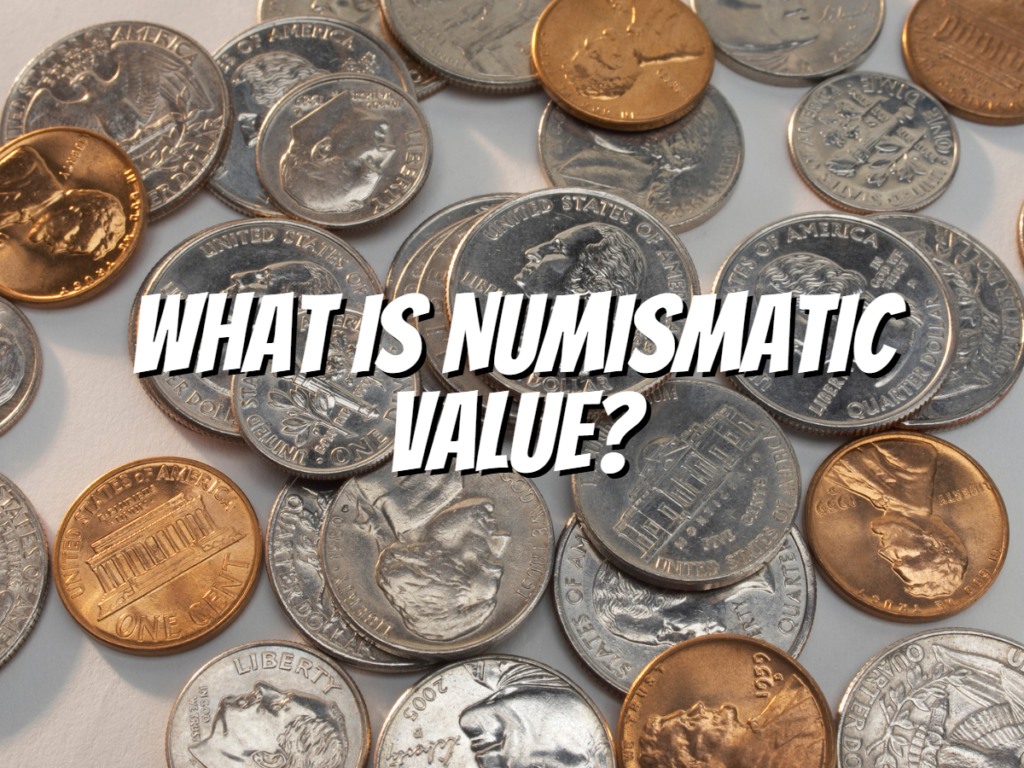Have you ever wondered what the meaning of numismatic value is? And how does it differ from face value and bullion value?
No need to worry! We’ll talk about these topics and the factors that affect numismatic value!
What is Numismatic Value?

Numismatic value is also known as collector value. The more of a particular coin in circulation, the less numismatic value it has.
You can purchase goods or services at face value (the printed amount on the front) if a coin has little or no numismatic value.
For example, if you have an American quarter from 1964 with no minting error, it’s probably worth about 25 cents to you—you can go into any store and buy whatever you want with this coin.
However, if that same 1964 quarter has been certified as being in perfect condition by one of several professional grading companies like PCGS or NGC (NGC stands for Numismatic Guaranty Corporation), then its utility would be much higher.
It’s harder for someone else to get their hands on an uncirculated 1964-D Lincoln cent than an ordinary one; therefore it will be worth more money.
Numismatic Value Vs. Face Value
Face value is the amount printed and stamped directly on the coin or piece of paper.
The government designates a coin’s face value as its price to make it a legal currency.
Rounds are coins that do not have legal tender status and do not have a face value.
For instance, the back of a standard U.S. penny will read “One Cent”; the back of a nickel, “Five Cents”; and the back of a dime, well, you get the idea. The face value of the coin, or its value as money.
Numismatic Value Vs. Bullion Value
The term refers to gold, silver, and platinum when they are only viewed as metals, without consideration for any value derived from their use as coins or ornaments.
A coin’s bullion value is based on weight, fineness (the percentage of precious metal to overall mass), and the current price.
Factors That Affect Numismatic Value
Mintage

An essential element that affects a coin’s value is its mintage, which can be high or low.
Some years and mint marks are rare than others because each mint produces a different amount of coins each year.
For instance, the Philadelphia Mint produced over 100 million Wheat cents in 1909, compared to the San Francisco Mint’s production of only about 2.3 million.
Because fewer were produced, all 1909 cents from the “S” mint were more expensive than comparable coins from the Philadelphia Mint.
Some mint marks may be more desirable than others because they carry additional historical significance.
As an illustration, Morgan dollars produced in New Orleans and Carson City are typically more valuable than those produced at other mints.
Variety

Identifying variations even within a coin’s single date and mint mark is possible.
For example, each mint started issuing 1909 cents with the initials VDB at the bottom of the reverse.
The decision was reached to remove the initials going forward not long after production got going.
The fact that fewer VDB coins were produced increases their value, demonstrating how value and rarity frequently go hand in hand.
Numerous lesser-known variations can be overlooked by someone who is not an expert, including 1909 cents with the VDB initials.
Although many casual collectors aren’t aware of them, there are two more 1909 variations (the S over horizontal S and doubled die obverse).
Demand

A coin will typically cost more the more people who are interested in it there are.
For example, some of the most well-known series in American history are the Morgan and Peace Dollars, which are frequently more pricey than other series with an equivalent level of rarity.
Additionally, although these two iconic dollars have a long history of popularity, interest among collectors in other series can fluctuate.
For instance, as the years go by, interest in Buffalo nickels and Mercury dimes fluctuates, with little information as to why.
Collectible coins (such as half cents) are typically less sought-after and, as a result, are priced less expensively than other series with similar grades and conditions.
Condition

The condition of a coin is one of the most important factors that affect its value.
For example, a coin’s design ages more quickly the more it has been used.
Additionally, more wear generally results in a lower value. A complex process, coin grading is regarded by some collectors as both an art and a skill.
As a result, collectors and investors frequently use third-party grading services (TPGs) to get expert assessments and grade assignments.
A scale from 1 to 70 is used to grade coins. Poor one may denote high circulation and a hardly discernible design.
A coin with an MS 70 grade is flawlessly struck and completely uncirculated. The majority of the pieces are in the middle of the scale.
Before you go…
Numismatic value is essential in collecting coins, but it must be challenging to understand. We hope this article has helped you grasp the numismatic value and how it can affect your coin collection.
Check out my next article: “What is the Difference Between Bullion and Numismatic Coins.”
Related Articles:

